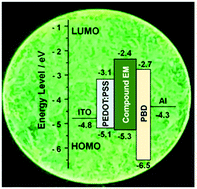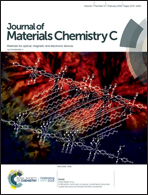Bipolar luminescent azaindole derivative exhibiting aggregation-induced emission for non-doped organic light-emitting diodes†
Abstract
In this paper, a new D–A bipolar luminescent azaindole is synthesized and fully characterized. The triphenylamine (TPA) derivative acting as a hole-transporting unit (D) and 2-cyanoacrylic acid acting as an electron-transporting unit (A) are incorporated in the same molecule. This luminogen, based on azaindole, presents aggregation-induced emission (AIE) characteristics. The theoretical calculations together with the photophysical characterization show the potential applicability of this new compound as electroluminescent material for non-doped OLEDs. A double-layer light-emitting device was developed showing that the presence of a better acceptor group in the azaindole derivative can reduce the electroplex and electromer formation in favor of the electron–hole recombination in the HOMO–LUMO of the molecule. These results pointed out the importance of the molecular design of the emissive material for a better OLED performance.



 Please wait while we load your content...
Please wait while we load your content...